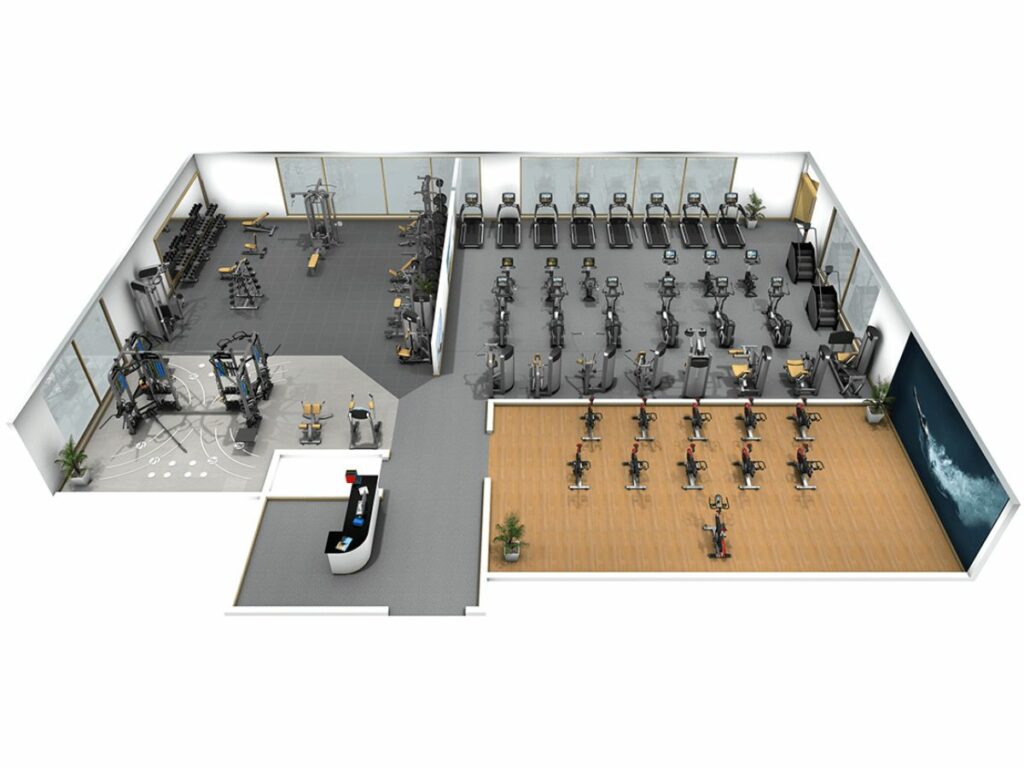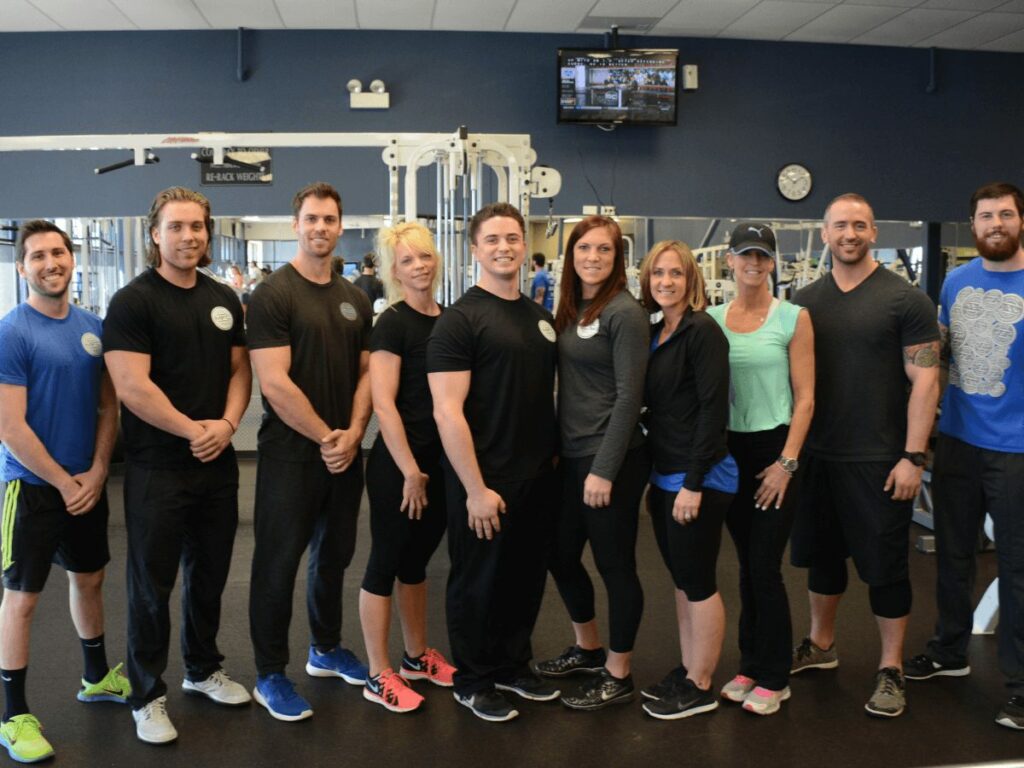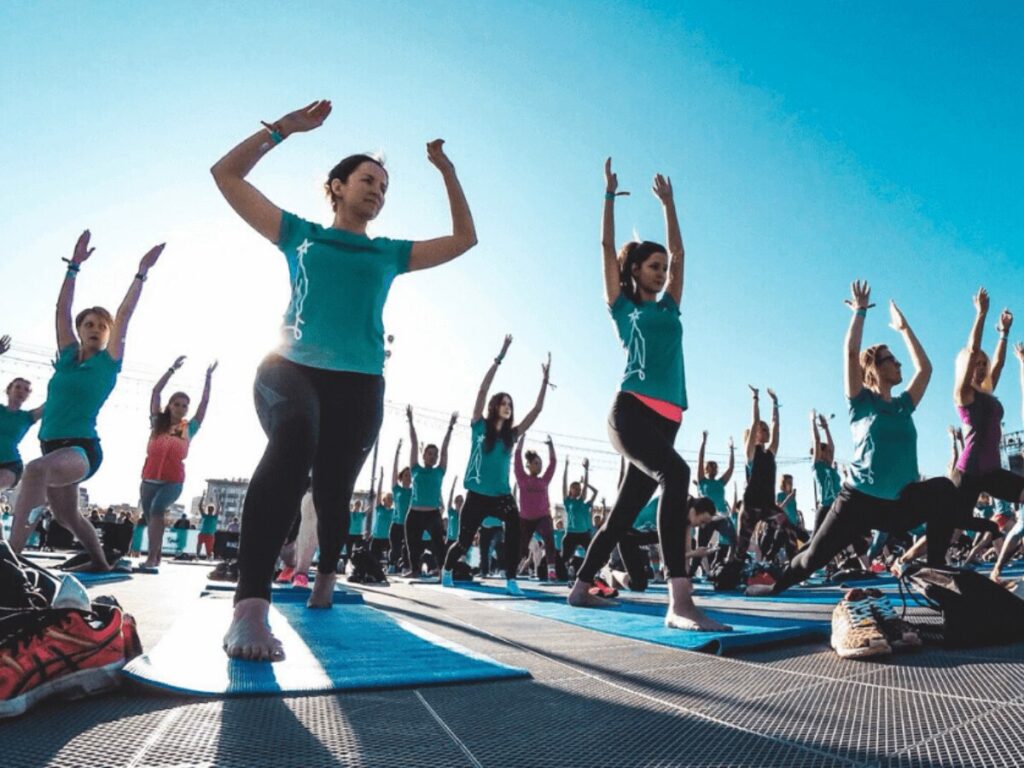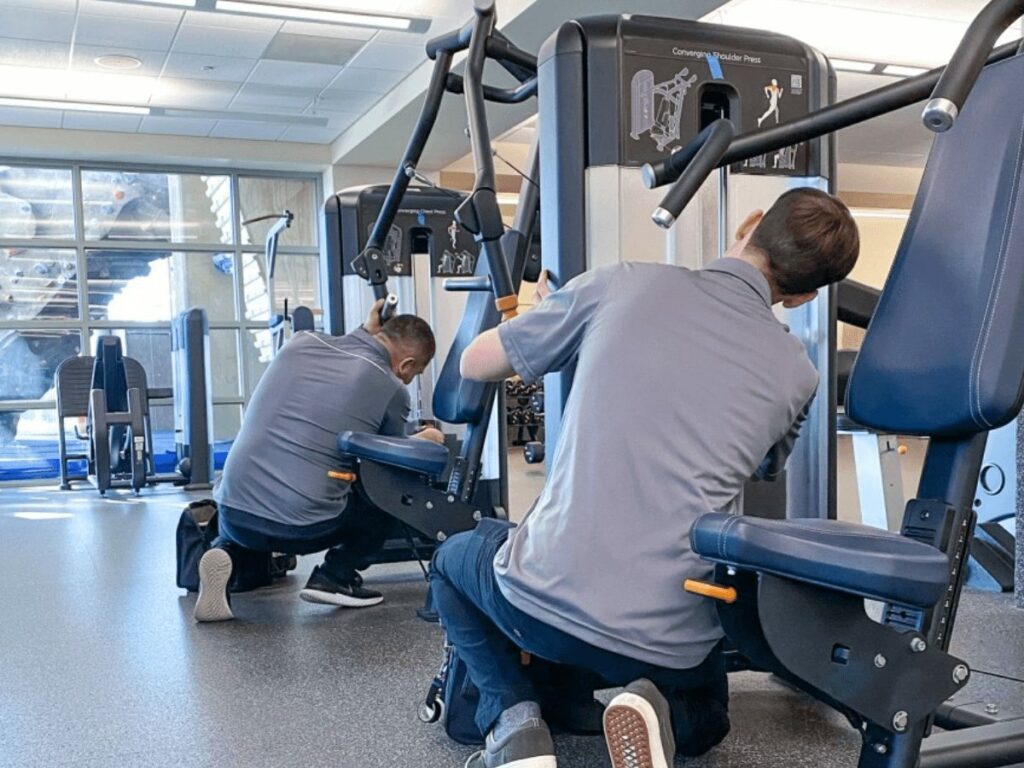Are you eager to break into the thriving fitness market and establish your presence as a commercial gym owner? What do you need to open a gym? Launching a commercial gym can be a rewarding enterprise, but it’s crucial to lay a strong foundation right from the outset.
Many gym entrepreneurs encounter various obstacles while navigating this competitive industry. Our in-depth guide will provide you with all the essential information needed to successfully open your own commercial gym.
Read on to discover valuable tips, strategies, and industry secrets.
Table of Contents
- 1. Understanding the Market
- 2. Creating a Business Plan
- 3. Choosing a Location
- 4. Acquiring Permits and Licenses
- 5. Finding the Right Equipment
- 6. Hiring Qualified Staff
- 7. Developing a Marketing Strategy
- 8. Building a Community
- 9. Managing Finances
- 10. Staying Up-to-Date With Industry Trends
- 11. Ensuring Safety and Liability
- 12. Offering a Variety of Services
- 13. Maintaining Equipment and Facilities
- 14. Measuring Success
- Conclusion
1. Understanding the Market
Navigating the fitness industry can be complex, but gaining a deep understanding of the market is crucial for success. As highlighted in an article from Zippia.com, the fitness industry has experienced remarkable growth, with its global value now exceeding $87 billion, driven by health-conscious consumers who are increasingly investing in their well-being. Let’s dive into some key areas to focus on:
Industry Trends
Staying on top of industry trends is a game-changer when it comes to setting your gym apart from the competition. By keeping your finger on the pulse, you can adapt to changes and attract a loyal clientele. Let’s dive into someexamplesof key points to watch:
- Tech Innovations: Embrace the latest advancements in fitness technology to enhance your clients’ workout experience. Think virtual classes, wearable fitness trackers, and connected gym equipment.
- Boutique Fitness Studios: Keep an eye on the rise of specialized boutique studios, which focus on a particular fitness niche, such as HIIT, cycling, or yoga. Consider incorporating niche classes or partnering with specialized studios.
- Holistic Wellness Approach: Today’s gym-goers increasingly seek a well-rounded wellness experience. Stay ahead by offering complementary services like nutrition consultations, mindfulness workshops, or recovery-focused amenities.
- Eco-friendly Practices: With growing awareness of environmental issues, adopting sustainable practices can make your gym more attractive to eco-conscious customers. Consider using energy-efficient equipment, offering reusable water bottles, or implementing a recycling program.
Target Demographics
As a fitness enthusiast who has spent years in the gym, I know the importance of catering to your target audience. It’s crucial to identify the specific needs of your customers and tailor your services to meet those needs. By doing so, you’ll not only ensure their satisfaction but also encourage long-term retention and growth for your gym.
Competitor Analysis
Throughout my journey as a gym expert, I’ve discovered the power of understanding my competition.By carefully examining their offerings and identifying gaps, I honed in on my gym’s unique selling points. This hands-on experience has been invaluable in setting my fitness center apart and gaining a competitive advantage in the industry.
2. Creating a Business Plan
Developing a solid business plan is a crucial step in launching a successful gym. A well-structured plan not only helps you secure funding, but also guides you through the complexities of starting and growing your fitness center. Let’s explore the essential components of an effective business plan:
Executive Summary
Present a clear and concise overview of your gym, including your mission statement, target market, and unique selling points. This section should capture the essence of your business and pique the interest of potential investors.
Market Analysis
As a gym expert, I’ve personally experienced the importance of understanding the fitness industry landscape.Through years of analyzing industry trends, target demographics, and competitor dynamics, I’ve gained invaluable insights. By sharing my knowledge, I aim to instill confidence in potential investors and partners, demonstrating that we can navigate this ever-evolving market together.
Financial Projections
As a gym expert with hands-on experience, I’ve learned the significance of accurate financial forecasting. In the early stages of my own fitness business, I meticulously calculated projected revenue, expenses, and profit margins. This attention to detail not only helped secure funding but also allowed for effective long-term management of my gym.

3. Choosing a Location
Selecting the perfect location for your gym is a critical decision that can make or break your business. A well-chosen location maximizes visibility, attracts your target audience, and fosters a loyal customer base. Consider these key factors when evaluating potential gym locations:
Demographics
As a gym owner who struggled with location selection in my early years, I’ve learned the importance of aligning the gym’s offerings with the target market’s preferences. Before opening a gym, analyze the local demographics to confirm that your offerings will resonate with the community. This approach will ensure that the gym is well-received, which is critical for long-term success.
Accessibility and Visibility
Look for a location that is easily accessible via public transportation, walking, or driving, with ample parking space. High visibility can help generate interest and draw in new customers organically.
Competition and Market Saturation
As a gym owner who struggled with high competition, I’ve learned the importance of researching nearby fitness centers before opening a gym. Choosing a location with less competition can increase your chances of success and allow your gym to stand out in the community. By avoiding oversaturated markets and direct competition, you can create a unique gym experience that attracts a loyal customer base.

4. Acquiring Permits and Licenses
Before opening your gym, it’s crucial to acquire the necessary permits and licenses to operate legally and avoid potential fines or closures. Navigating the world of permits and licenses can be complex, but a thorough understanding is essential for success. Consider the following aspects to ensure you’re fully compliant:
Local Business Permits
As a gym owner who encountered legal hurdles in the past, I know the importance of complying with local regulations. Before opening a gym, it’s crucial to check with your city or county government to determine which business permits you need. Requirements may vary depending on your location, so it’s important to be aware of and comply with all local regulations to ensure a successful gym business.
Youtube Link :
Health and Safety Regulations
Familiarize yourself with health and safety guidelines for fitness centers, such as fire codes, equipment maintenance, and sanitation standards. Compliance with these regulations is vital to ensure a safe environment for your clients and staff. Here are a few examples of certificates that commercial gym owners should be aware of:
- Fire Safety Certificate: Commercial gyms should obtain a fire safety certificate from their local fire department. This ensures that the gym meets all fire safety regulations and that staff members are trained in proper fire safety protocols.
- Food Handling Certification: If your gym offers any type of food or drink, such as smoothies or protein bars, staff members who handle food should have a food handling certification. This ensures that they understand proper food handling techniques to avoid contamination and foodborne illnesses.
Professional Certifications
I understand the value of professional certifications in the fitness industry. It not only ensures that you have the necessary skills and knowledge to provide effective training, but also demonstrates your dedication to continuous learning and improvement. I highly recommend investing in certifications for yourself and your staff to provide the best possible experience for your clients.
Professional certifications in the fitness industry are essential for ensuring competency, credibility, and providing high-quality training services. They demonstrate a commitment to professional development and continuous learning. Here are some notable certifications in the fitness industry:
| Certification | Description |
| ACE Certified Personal Trainer | Accredited certification from the American Council on Exercise, validating expertise in personal training. |
| NASM Certified Personal Trainer | Certification by the National Academy of Sports Medicine, indicating proficiency in personal training techniques. |
| ACSM Certified Exercise Physiologist | Recognized certification by the American College of Sports Medicine, focusing on exercise prescription and programming for individuals with chronic diseases or disabilities. |
| NSCA Certified Strength and Conditioning Specialist | Certification from the National Strength and Conditioning Association, emphasizing strength and conditioning for athletes and sports performance. |
| AFAA Group Fitness Instructor | Accredited certification from the Athletics and Fitness Association of America, specializing in leading group fitness classes and creating engaging workouts. |
| Precision Nutrition Certification | Certification program focused on nutrition coaching and dietary guidance for individuals seeking to improve their overall health and fitness. |
| Yoga Alliance Registered Yoga Teacher | Certification for yoga instructors, recognized by the Yoga Alliance, ensuring knowledge of yoga philosophy, anatomy, and teaching methodology. |
| CrossFit Level 1 Trainer | Certification for trainers in the CrossFit methodology, covering functional fitness, Olympic weightlifting, and high-intensity workouts. |
| Pilates Method Alliance (PMA) Certification | Certification for Pilates instructors, demonstrating proficiency in the Pilates method and principles of movement. |
| TRX Suspension Training Course | Certification program focusing on utilizing TRX suspension training equipment for strength, stability, and functional exercises. |
5. Finding the Right Equipment
High-quality gym equipment is crucial for success in the fitness industry, as it attracts and retains clients while improving the overall gym experience.From my personal experience, investing in the right equipment was key to my gym’s success. When picking gym equipment, keep these factors in mind:
Target Audience
Tailor your equipment choices to the needs and preferences of your target demographic.For instance, a gym catering to bodybuilders will require different equipment than one focused on functional fitness or group classes.
Quality and Durability
When equipping your gym, it’s essential to choose high-quality equipment from reputable manufacturers like Yanre Fitness. The initial cost may be higher, but investing in premium equipment will save you money in the long run by reducing maintenance and replacement costs. Don’t sacrifice quality for price, as subpar equipment can lead to injuries and unhappy customers.
Space and Layout
From my experience in the fitness industry, it’s essential to assess your gym’s layout and available space before selecting and distributing equipment. Proper organization not only enhances safety and functionality, but it can also improve the overall experience for your gym members.

6. Hiring Qualified Staff
A team of qualified and passionate staff is the backbone of any successful gym. Hiring the right people not only ensures top-notch service but also fosters a positive and welcoming atmosphere for your clients. Keep the following points in mind when building your dream team:
Skills and Certifications
Prioritize candidates with relevant skills, experience, and professional certifications in personal training, group fitness instruction, or other specialized areas. This demonstrates their commitment to the industry and ensures a high standard of service. Here are some examples of skills and certifications:
- Personal Training Certification: This is a must-have for any personal trainer at your gym. A valid certification from a recognized organization such as ACE,NASM, or ISSA shows that your trainers have the necessary knowledge and skills to create effective exercise programs for clients.
- CPR/AED Certification: Safety should always come first at your gym. All gym staff, especially personal trainers, should be trained in CPR and AED use to ensure they can respond to emergencies.
- Strong Communication Skills: The best trainers and gym staff have excellent communication skills. They can listen actively, provide clear instructions, and motivate clients to achieve their fitness goals.
Passion and Personality
As a gym expert with years of experience in the industry, I’ve found that having passionate and motivated staff is key to creating a successful gym environment. In my personal experience, hiring staff members who share my enthusiasm for fitness has led to better client retention and overall satisfaction.
Ongoing Training and Development
As a gym expert, I’ve learned from personal experience that investing in staff training and development is crucial to maintaining and improving the quality of gym services. By continuously upskilling your employees, you not only help them grow but also elevate the overall quality of your gym’s offerings.

7. Developing a Marketing Strategy
A well-crafted marketing strategy is crucial for raising awareness about your gym and attracting new clients. By leveraging various marketing channels and tactics, you can effectively promote your fitness center and boost revenue. Focus on these key areas when developing your marketing plan:
Branding and Positioning
As a gym expert with years of experience, I’ve learned that establishing a strong brand identity is crucial to differentiate your fitness center from competitors. By reflecting your gym’s mission, values, and unique selling points, you can resonate with your target audience and build a loyal client base.
Digital Marketing
If you’re looking to expand your gym’s reach and attract more members, it’s time to embrace the power of digital marketing. Here are five examples of digital marketing strategies that can help your gym grow:
- Social Media Advertising: Utilizing platforms like Facebook and Instagram, you can create targeted ads that reach potential gym-goers in your area. These ads can showcase your gym’s amenities, classes, and any promotions you’re offering.
- Content Marketing: By creating blog posts, videos, or social media content that provides value to your audience, you can position your gym as a trusted source of fitness information. This can help build trust and loyalty among your members and attract new ones.
- Email Marketing: Keeping your members engaged and informed is crucial for retention. By sending regular newsletters or promotional emails, you can keep your gym top of mind and increase the likelihood of repeat business.
- Search Engine Optimization (SEO): By optimizing your gym’s website with relevant keywords and quality content, you can increase your visibility on search engines like Google. This can lead to more organic traffic and potential new members finding your gym online.
- Influencer Marketing: Partnering with fitness influencers or local athletes can help showcase your gym to their followers and increase your brand’s reach. This can also help establish your gym as a go-to destination for fitness enthusiasts.
Community Involvement
As a certified fitness instructor with over a decade of experience, I’ve seen how community engagement can benefit both the commercial gym and its members. Hosting charity events or partnering with local sports teams can showcase the gym’s commitment to giving back while attracting potential new members.

8. Building a Community
As someone who has been a gym-goer for years, I’ve experienced the power of a supportive fitness community. Encourage group workouts, social events, and personalized training plans to create a positive gym experience that keeps members coming back. Invest in community-building strategies to create a gym that clients are proud to belong to. For a vibrant gym community, implement these strategies:
Host Events and Workshops
Organize gym events, workshops, and challenges to encourage client interaction and engagement. These activities provide opportunities for members to learn, connect, and have fun, strengthening the bonds within your gym community.
Encourage Member Interaction
Having worked in the fitness industry for years, I understand the importance of creating an inclusive environment for gym-goers. This can be achieved through initiatives such as offering beginner-friendly classes, providing personal training, or hosting events that encourage socializing. Create a welcoming space to attract diverse members and foster a community for long-term retention.
Show Appreciation and Recognition
Acknowledge your members’ achievements and milestones, whether it’s through social media shoutouts, member spotlights, or small rewards. Demonstrating your appreciation helps build personal connections and reinforces the sense of belonging within your community.
9. Managing Finances
As someone who has managed gyms in the past, I know firsthand the importance of financial management. Tracking expenses, monitoring revenue, and forecasting future growth are crucial components of running a successful gym. Analyze financial data to make informed decisions for sustained profitability. Key areas to consider for gym financial management:
Budgeting and Forecasting
Develop a comprehensive budget that accounts for all expenses and revenue streams, including equipment, staffing, and marketing. Regularly update your financial forecasts to ensure you’re on track to achieve your financial goals.
Cash Flow Management
Maintaining a healthy cash flow is essential for any gym to operate smoothly and remain financially viable. As a gym expert, I have seen how closely monitoring cash flow can prevent unforeseen financial issues and promote long-term success. Effective cash management practices, such as optimizing payment processing and managing expenses, can go a long way in ensuring your gym’s financial stability.
Financial Reporting and Analysis
Regularly review your gym’s financial statements to identify trends, opportunities, and areas for improvement. Analyzing key financial metrics, such as profit margins, customer acquisition costs, and membership retention rates, can provide valuable insights to guide your business decisions.
10. Staying Up-to-Date With Industry Trends
Keeping up with industry trends is essential for staying competitive and meeting the evolving needs of your clients. By staying informed about the latest innovations and developments in fitness, you can adapt and grow your gym effectively. Consider these methods to stay up-to-date with industry trends:
Industry Publications and Research
Regularly read industry publications, such as fitness magazines and journals, to stay informed about emerging trends and best practices. Subscribing to research reports from reputable organizations can also provide valuable insights and data.
Networking and Events
Attend industry events, conferences, and trade shows to connect with fellow professionals and learn from experts in the field. Networking can lead to valuable partnerships and help you stay informed about the latest developments.
Online Communities and Social Media
Follow industry influencers, blogs, and online forums to keep a pulse on the latest trends and conversations. Engaging with social media and online communities can help you gather diverse perspectives and stay ahead of the curve.
11. Ensuring Safety and Liability
Ensuring the safety of your gym and minimizing liability risks is crucial for protecting both your clients and your business. By implementing robust safety measures and adhering to industry standards, you can create a secure environment that fosters client trust. Focus on these key areas when addressing safety and liability concerns:
Facility Maintenance and Inspection
Regularly inspect and maintain all gym equipment to ensure it’s in proper working order. Address any issues promptly and establish a schedule for routine maintenance to prevent accidents or equipment failure.
Staff Training and Certification
Ensure your staff members are well-trained in safety protocols and hold the appropriate certifications. By maintaining a knowledgeable team, you can reduce the risk of accidents and promote a safe environment for clients.

Insurance and Liability Waivers
Obtain comprehensive insurance coverage to protect your gym from potential liability claims. Additionally, require members to sign liability waivers to help safeguard your business in the event of injuries or accidents on the premises.
12. Offering a Variety of Services
Offering a variety of services at your gym can attract a diverse clientele and boost revenue. By catering to different fitness preferences and goals, you can set your gym apart from competitors and provide added value for your clients. Consider incorporating these service options into your gym’s offerings:
Group Fitness Classes
Introduce group classes in various disciplines, such as yoga, spinning, or HIIT, to cater to a wide range of interests. Offering a diverse class schedule can keep clients engaged, motivated, and more likely to renew their memberships.
Personal Training and Nutrition Services
Provide personal training and nutrition consultations to help clients achieve their individual fitness goals. These one-on-one services can generate additional revenue and enhance your gym’s reputation for delivering results.

Specialized Programs and Workshops
Organize specialized programs, such as weight loss challenges, pre/postnatal fitness classes, or workshops on specific topics like injury prevention. These targeted offerings can help you reach niche markets and create a more comprehensive fitness experience.
13. Maintaining Equipment and Facilities
As a gym expert, I understand the importance of equipment maintenance from my own experience. I’ve seen firsthand how poorly maintained machines can cause injuries and discourage clients from returning. By taking care of your gym’s facilities, you’re investing in the success of your business and the safety of your clients.To maintain your equipment and facilities, focus on these key areas:
Equipment Inspection and Repair
As a gym owner, I’ve learned the importance of regularly inspecting equipment for wear and tear. This not only ensures the safety of my clients but also prevents equipment failure and costly repairs. By scheduling routine maintenance and addressing any issues promptly, you can keep your gym running smoothly and maintain a high level of customer satisfaction.
Cleanliness and Hygiene
Establish strict cleaning protocols for your staff and clients to maintain a hygienic and pleasant environment. Provide ample sanitizing stations, regularly clean all surfaces, and enforce gym hygiene rules to minimize the risk of illness and infections.
Facility Upgrades and Improvements
As a commercial gym owner, it’s important to regularly assess your facility and make necessary upgrades to keep up with industry trends and meet the needs of your members. Consider investing in Yanre Fitness gym equipment manufacturers for quality and innovative equipment options. Improving your gym’s amenities and design can also help attract and retain customers.

14. Measuring Success
As a gym expert, I’ve learned from my own experiences how crucial it is to create a positive and welcoming environment for clients. By fostering a community-oriented atmosphere and offering quality customer service, I was able to build lasting relationships with members and increase retention rates. This ultimately led to the success and growth of my gym. Important factors to measure gym success:
Financial Performance
Analyze financial indicators such as revenue, profit margins, and cash flow to determine the overall financial health of your business. Regularly reviewing these metrics can help you identify trends and make adjustments to improve profitability.
Membership Metrics
As a gym expert, I know firsthand how critical it is to invest in high-quality equipment and facilities. By providing clients with top-notch amenities, you can enhance their experience and promote safety. This can help to build a positive reputation for your gym, leading to increased client satisfaction and retention rates.
Customer Satisfaction
Gather feedback from your clients through surveys, reviews, and direct conversations to assess their overall satisfaction. Use this information to improve your services, facilities, and customer experience, ultimately fostering loyalty and positive word-of-mouth marketing.

Conclusion
In conclusion, opening a successful gym requires thorough research, planning, and execution. By considering key aspects such as understanding the market, creating a business plan, selecting the right location, acquiring permits, and investing in quality equipment and staff, you can set your gym up for long-term success and profitability.
To help you get started,Yanre Fitness offers a wide range of top-quality gym equipment, expert guidance, and excellent customer service. We invite you to contact us for more information, product catalogs, price lists, or assistance in planning and launching your gym.
Related articles:








